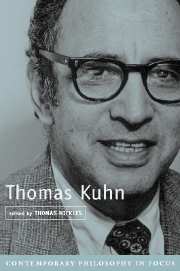Book contents
- Frontmatter
- Contents
- Contributors
- Preface
- Introduction
- 1 Kuhn and Logical Empiricism
- 2 Thomas Kuhn and French Philosophy of Science
- 3 Normal Science and Dogmatism, Paradigms and Progress: Kuhn ‘versus’ Popper and Lakatos
- 4 Kuhn's Philosophy of Scientific Practice
- 5 Thomas Kuhn and the Problem of Social Order in Science
- 6 Normal Science: From Logic to Case-Based and Model-Based Reasoning
- 7 Kuhn, Conceptual Change, and Cognitive Science
- 8 Kuhn on Concepts and Categorization
- 9 Kuhn's World Changes
- 10 Does The Structure of Scientific Revolutions Permit a Feminist Revolution in Science?
- Selected References in English
- Index
- References
8 - Kuhn on Concepts and Categorization
Published online by Cambridge University Press: 07 December 2009
- Frontmatter
- Contents
- Contributors
- Preface
- Introduction
- 1 Kuhn and Logical Empiricism
- 2 Thomas Kuhn and French Philosophy of Science
- 3 Normal Science and Dogmatism, Paradigms and Progress: Kuhn ‘versus’ Popper and Lakatos
- 4 Kuhn's Philosophy of Scientific Practice
- 5 Thomas Kuhn and the Problem of Social Order in Science
- 6 Normal Science: From Logic to Case-Based and Model-Based Reasoning
- 7 Kuhn, Conceptual Change, and Cognitive Science
- 8 Kuhn on Concepts and Categorization
- 9 Kuhn's World Changes
- 10 Does The Structure of Scientific Revolutions Permit a Feminist Revolution in Science?
- Selected References in English
- Index
- References
Summary
INTRODUCTION
In Kuhn's account of the history of science, the nature of concepts and conceptual change looms large. Kuhn found little to admire in contemporary philosophical accounts of science, and he also found himself at odds with the philosophical community on the theory of concepts. Consequently, in the course of developing his philosophical account of science, he was also obliged to articulate a theory of concepts. One of the central ideas of his account, incommensurability, originated as a thesis about concepts. As his account matured, Kuhn came to formulate incommensurability as a thesis about taxonomies. The issue of categorization therefore emerges immediately from his account, with his theory of concepts providing the basis for the conceptual structures that he calls “kind hierarchies.”
Kuhn's theory is not without precedent. It builds on the work of Wittgenstein and also reflects Kuhn's early and profound exposure to Kant. In a revealing interview near the end of his life Kuhn said simply, “I am a Kantian with movable categories” (Baltas, Gavroglu, and Kindi 2000, p. 264). Provided that the categories are understood as Wittgensteinean family resemblance concepts, this is a valuable summary. As his philosophy of science developed, Kuhn focused increasingly on the nature of scientific concepts, and his account of concepts gradually became the foundation from which he sought to vindicate his earlier claims on the development and change of scientific knowledge.
- Type
- Chapter
- Information
- Thomas Kuhn , pp. 212 - 245Publisher: Cambridge University PressPrint publication year: 2002
References
- 6
- Cited by

